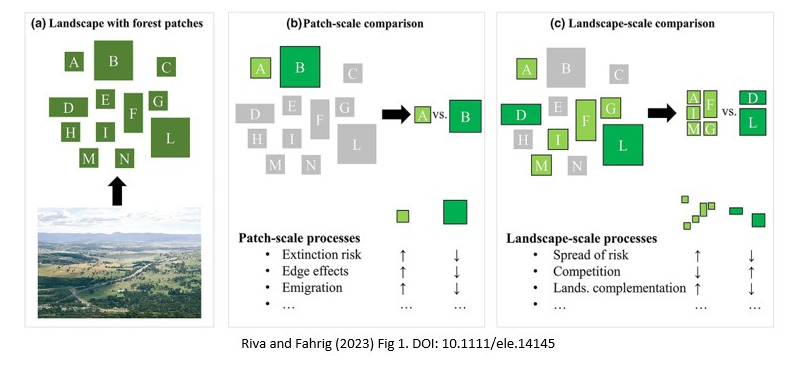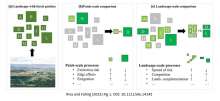
As a landscape ecologist working on biodiversity conservation, you might be asked, “isn’t the size of a habitat patch all that matters?” or “why should we care about landscapes?”. A recent study by Federico Riva and Lenore Fahrig in Ecology Letters provides another example of why considering landscape context is vital for biodiversity conservation, contributing more grist to the mill of the SLOSS debate (whether a Single Large Or Several Small patches is better for biodiversity conservation).
Riva and Fahrig analysed 71 datasets of habitat patch size and species richness, a total of 4351 taxa in 1149 patches, from the FragSAD database for habitat-fragmented landscapes around the world. Their study was essentially a re-analysis of a previous study published in Nature by Jonathan Chase and colleagues. The Chase study found that small habitat patches had lower biodiversity (e.g., species richness) than would be expected because of their small size alone, citing the allied loss of ecosystem function as a compounding effect along with less habitat (an effect called 'ecosystem decay’).
But whereas Chase and colleagues examined the effect of habitat patch size on biodiversity by comparing individual patches (the ‘patch-level’ of analysis), Riva and Fahrig compared sets of patches with consistent total area but varying mean patch size (the ‘landscape-level’ of analysis). In doing so, they aimed to examine whether the patch-level result could simply be extrapolated to broader extents at the landscape-level (see Figure 1 from Riva and Fahrig below).

If the patch-level result found by Chase and colleagues applies at the landscape-level, Riva and Fahrig logically argued that for the same total habitat area, landscapes with smaller (but more numerous) patches should have lower biodiversity than landscapes with larger (but less numerous) patches. And yet on analysis of their datasets, they found the opposite pattern. That is, “for sets of patches with equal total habitat area, species richness and evenness decrease with increasing mean size of the patches comprising that area, even when considering only species of conservation concern.”
To explain this difference between the patch-level and landscape-level relationships, Riva and Fahrig suggest two processes – extinction risk and ecological drift. Although extinction risk does increase as individual habitat patch size decreases, this could be compensated at the landscape level because small patches are more numerous (for a given total landscape habitat area). And while ecological drift can increase the chance of extinction in individual small patches because of their small populations, it can also increase biodiversity across many small patches because of reduced competition for the same resources (as more patches means a greater chance of a range of resources) and a greater chance of alternative community assemblages in the different patches.
The landscape-level result – that for a given amount of habitat more numerous small patches support higher biodiversity than fewer large patches – falls squarely on the SS side of the SLOSS debate and exemplifies the high value of small habitat patches for biodiversity. Riva and Fahrig themselves highlight how many landscapes in Europe and North America are supporting populations of species that have traditionally been thought to require large habitat patches to survive, such as bears, lynx and wolves.
Of course, more generally we should be aiming to maximise total habitat – whether in small or large patches – to ensure the persistence of the most species possible. But studies like this one are important to bear in mind in fragmented landscapes as we work towards achieving the goal of the Kunming-Montreal Global Biodiversity Framework to conserve 30% of Earth’s surface and re-emphasises yet again the importance of a landscape ecology perspective.
James Millington, April 2023 (CC-BY)
Note to the reader: Whereas Riva and Fahrig use the phrases ‘patch-scale’ and ‘landscape-scale’, here I prefer ‘patch-level’ and ‘landscape-level’ given my understanding of the difference between ‘scale’ and ‘level’ (see Millington, 2022).
References
Chase, J. M., Blowes, S. A., Knight, T. M., Gerstner, K., & May, F. (2020). Ecosystem decay exacerbates biodiversity loss with habitat loss. Nature, 584(7820), 238-243. https://doi.org/10.1038/s41586-020-2531-2 [See a freely available summary of that paper here]
Millington, J. D. A. (2022) Scale and hierarchy in landscape ecology In: Francis, R. A., Millington, J. D. A., Perry, G. L. W. and Minor, E. S. (Eds.) The Routledge Handbook of Landscape Ecology. Abingdon: Routledge, 49-66. https://doi.org/10.4324/9780429399480-4 [A pdf version freely available here]
Riva, F., & Fahrig, L. (2023). Landscape‐scale habitat fragmentation is positively related to biodiversity, despite patch‐scale ecosystem decay. Ecology Letters, 26(2), 268-277. https://doi.org/10.1111/ele.14145 [To find a freely available version, search Google Scholar]
